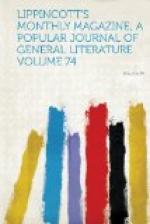Shakespeare’s Autobiographical Poems, by Charles Armitage Brown (1838), is the book which more than all others on the subject seems to have excited Mr. Massey’s indignation, chiefly because it is the leading advocate of “the personal theory”—that is, the autobiographical and non-dramatic character of the poems. This implies an acceptance of the statement clearly made in the Sonnets of Shakespeare’s infidelity to his wife; and this Mr. Massey pronounces an outrageous and unwarranted slander. But in order to leave the name of Shakespeare pure from any stain of mortal imperfection, Mr. Massey arranges a dramatic intention for the Sonnets which involves, with more or less of light or evil conduct, no less than four other names—the earl of Southampton and Elizabeth Vernon (daughter of Sir John Vernon), whom he afterward married; William Herbert, earl of Pembroke, and Lady Rich, for whom Mr. Massey finds no words too abusive, and whom he considers the “worser spirit” of the later Sonnets. The history of this lady is sufficiently well known, and, so far as I can ascertain, there is no historical warrant for supposing her to have been the mistress of Herbert, or the beguiler of Southampton into such a lapse of duty to his beloved Elizabeth Vernon as should inspire the expressions of Sonnets 134, 133, 144, which Mr. Massey says are written in the person of this lady to Lady Rich. Lady Penelope Devereux, sister of Essex, was born in 1563, and her father, who died when she was but thirteen, expressed a desire that she should be married to Sir Philip Sidney. For some unknown reason the intended match was broken off, and the fair Penelope, who is described as “a lady in whom lodged all attractive graces of beauty, wit and sweetness of behavior which might render her the absolute mistress of all eyes and hearts,” was married in 1580 to Lord Rich, a man whom she detested. Sidney’s Astrophel and Stella, a series of one hundred and eight sonnets and poems addressed to Lady Rich, and celebrating the strength and the purity of their love for each other, was first printed in 1591. Sidney had died five years before, and so long as he lived, at




